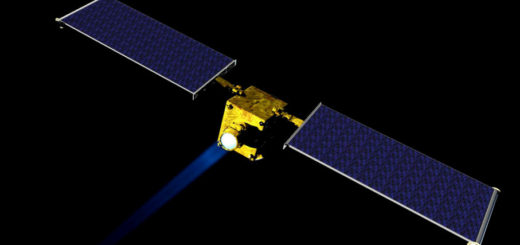Mysterious Death Star Beams From Black Holes Investigated

Nicknamed Death Star beams, they are nature’s very own ultra-powerful jets of energy that emerge from the vicinity of black holes. It’s a mysterious cosmic phenomenon and how these powerful jets form remains a puzzle.
One theory suggests that they develop within the ‘accretion disc’ — the matter sucked into the orbit of a growing black hole. Extreme gravity within the disc twists and stretches magnetic fields, squeezing hot, magnetized disc material called plasma until it erupts in the form of oppositely directed magnetic pillars along the black hole’s rotational axis.
Artist’s impression of the V404 Cygni black hole jet. Credit: G Perez Diaz IAC
Plasma travels along these focused jets and gains tremendous speed, shooting across vast stretches of space. At some point, the plasma begins to shine brightly, but how and where this occurs in the jet has been debated by scientists.
Scientists from the University of Southampton have tried to unravel the mystery of these extremely powerful jets that remind of deadly rays from the Star Wars super-weapon.
Dr. Poshak Gandhi and an international team of scientists have observed a binary system called V404 Cygni that is located about 7,800 light years away in the constellation of Cygnus, and weighs as much as about nine of our Suns put together.
V404 Cygni consists of a star and a black hole closely orbiting each other, with the black hole feeding off matter from the star that falls through the disc — to throw light on this hotly debated phenomenon.
Dr Gandhi and his collaborators captured the data in June 2015, when V404 Cygni was observed radiating one of the brightest ‘outbursts’ of light from a black hole ever seen — bright enough to be visible to small telescopes used by amateur astronomers, and energetic enough to tear apart an Earth-like planet if properly focused.
Using telescopes on Earth and in space observing at exactly the same time, they captured a 0.1-second delay between X-ray flares emitted from near the black hole, where the jet forms, and the appearance of visible light flashes, marking the moment when accelerated jet plasma begins to shine.
This ‘blink of an eye’ delay was calculated to represent a maximum distance of 19,000 miles (30,000 km), impossible to resolve at the distance of V404 with any current telescope.
Dr Gandhi, of the University of Southampton, said: “Scientists have been observing jets for decades, but are far from understanding how nature creates these mind-bogglingly vast and energetic structures.
See also:
Black Holes May Be Holograms And Proof We Are Living In A Holographic Universe
Black Holes May Have Filled The Universe With Light
Parallel Universes May Be Hidden Inside Supermassive Black Holes
More About Astronomy
“Now, for the first time, we have captured the time delay between the appearance of X-rays and the appearance of optical light in a stellar-mass black hole at the moment jet plasma is activated. This lays to rest the controversy regarding the origin of the optical flashes, and also gives us a critical distance over which jet plasma must have been strongly accelerated to speeds approaching that of light.”
In Star Wars terms, the key measurement of this study can roughly be likened to measuring the distance between the surface of the Death Star, where multiple rays of light shoot out, and the point where they converge into a single bright beam.
“But the physics of black hole jets has nothing to do with lasers or the fictional Kyber crystals that power the Death Star. Nature has found other ways to power jets,” said Dr Gandhi. “Gravity and magnetic fields play the key roles here, and this is the mechanism we are trying to unravel.”
The study also creates a link between V404 Cygni and supermassive black holes, which lie at the centre of massive galaxies and which weigh billions of times more than stellar-mass black holes. Similar jet physics may apply to all black holes.
Dr Gandhi said: “This is an exciting and important discovery which can be fed back into theory about relativistic jets, and contributes to our ever-growing understanding of black holes.”



 Creators of mankind
Creators of mankind Description of “Tall white aliens”
Description of “Tall white aliens” Where they came from?
Where they came from? About hostile civilizations
About hostile civilizations The war for the Earth
The war for the Earth “Tall white aliens” about eternal life
“Tall white aliens” about eternal life Video: “Nordic aliens”
Video: “Nordic aliens” Aliens
Aliens Alien encounters
Alien encounters The aliens base
The aliens base UFO
UFO Technology UFO
Technology UFO Underground civilization
Underground civilization Ancient alien artifacts
Ancient alien artifacts Military and UFO
Military and UFO Mysteries and hypotheses
Mysteries and hypotheses Scientific facts
Scientific facts


















